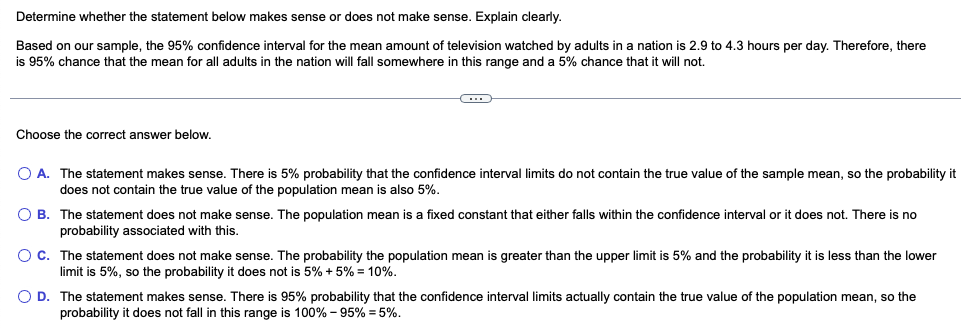Determine whether the statement below makes sense or does not make sense. Explain clearly.
Determine whether the statement below makes sense or does not make sense. Explain clearly.
Glencoe Algebra 1, Student Edition, 9780079039897, 0079039898, 2018
18th Edition
ISBN:9780079039897
Author:Carter
Publisher:Carter
Chapter10: Statistics
Section10.1: Measures Of Center
Problem 13PPS
Related questions
Question

Transcribed Image Text:Determine whether the statement below makes sense or does not make sense. Explain clearly.
Based on our sample, the 95% confidence interval for the mean amount of television watched by adults in a nation is 2.9 to 4.3 hours per day. Therefore, there
is 95% chance that the mean for all adults in the nation will fall somewhere in this range and a 5% chance that it will not.
C
Choose the correct answer below.
O A. The statement makes sense. There is 5% probability that the confidence interval limits do not contain the true value of the sample mean, so the probability it
does not contain the true value of the population mean is also 5%.
O B. The statement does not make sense. The population mean is a fixed constant that either falls within the confidence interval or it does not. There is no
probability associated with this.
O C. The statement does not make sense. The probability the population mean is greater than the upper limit is 5% and the probability it is less than the lower
limit is 5%, so the probability it does not is 5% + 5% = 10%.
O D. The statement makes sense. There is 95% probability that the confidence interval limits actually contain the true value of the population mean, so the
probability it does not fall in this range is 100% - 95% = 5%.
Expert Solution
This question has been solved!
Explore an expertly crafted, step-by-step solution for a thorough understanding of key concepts.
This is a popular solution!
Trending now
This is a popular solution!
Step by step
Solved in 2 steps

Recommended textbooks for you

Glencoe Algebra 1, Student Edition, 9780079039897…
Algebra
ISBN:
9780079039897
Author:
Carter
Publisher:
McGraw Hill

Glencoe Algebra 1, Student Edition, 9780079039897…
Algebra
ISBN:
9780079039897
Author:
Carter
Publisher:
McGraw Hill